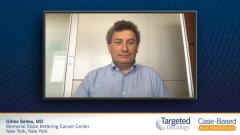
Results of the L-MIND Clinical Trial
Gilles Salles, MD: Recently we have new options available for patients with relapsed or refractory diffuse large B-cell lymphoma [DLBCL] since the FDA approved the combination of tafasitamab and lenalidomide for relapsed/refractory diffuse large B-cell lymphoma that is transplant ineligible. What is this combination? Tafasitamab is a CD19-directed antibody that has been engineered to improve the ADCC [antibody-dependent cellular cytotoxicity] and ADCP [antibody-dependent cellular phagocytosis] mechanisms of action. When engaging the antigen on the surface of the tumor cells, the modification of this antibody increases the ability of the immune cells to kill the tumor cells. Based on this rationale and on some experimental data, the combination of this antibody with lenalidomide was logical to test, given that we know that lenalidomide is able to increase the activities of some of the cytotoxic cells, such as NK [natural killer] cells.
The key study that led to the approval of tafasitamab and lenalidomide was called the L-MIND study. This was a phase 2, open-label study that enrolled patients who were transplant ineligible in the first or second line of relapse, with only a few patients who were actually refractory to first line. The primary end point was the overall response rate, and the overall response rate in the whole population reached 62%; in patients with true DLBCL it was 57%. The complete response rate was a total of 42.5%, and if you examine only the DLBCL it was 37%.
Reaching this kind of response rate with a regimen that is not chemotherapy-based but an immune-based regimen, is really encouraging. What we are seeing with this trial is that the progression-free survival was in a 12-month range, which is an important result for a second-line regimen in transplant-ineligible patients. Duration of response was really prolonged, and it was greater than 18 months on the last follow-up we had with the trial. If we specifically address the patients who have had a complete response to a combination of tafasitamab and lenalidomide, about 80% of these patients were still in response at 18 months.
I want to come back to the way this regimen is delivered. We have tafasitamab, which is infused initially weekly and then every 2 weeks. Lenalidomide is prescribed at the usual dose: 21 days, of 28. This is a combination that is given in 1 year. All patients have benefited from this kind of therapy with continuing tafasitamab as a single agent, 1 infusion every 2 weeks.
We recently updated the result of this trial, and the response rates that I described and the duration of response were confirmed with recent data. The median overall survival of these patients is in the range of close to 3 years, which is very encouraging for patients who are not transplant eligible.
I presented the data on the efficacy of this regimen in different categories of patients, and we found that there were no clear major differences in terms of patients who benefited from this combination. Patients who were treated at the time of first relapse or had the lower IPI [International Prognostic Index score], had a nonsignificant tendency to have a higher response rate. We have a few patients who were primary refractory who were not like this patient, but had an early failure just after completing R-CHOP [rituximab plus cyclophosphamide, doxorubicin, vincristine, and prednisone], and still a substantial number of them responded, as well as patients who were refractory to the second line of therapy. We had a few with transforming lymphoma who responded well, as well as response observed in patients with a higher tumor bulk.
Interestingly, lenalidomide has been described as active in patients with non-GCB [germinal center B-cell] tumors, so patients who have the genotype of activated B-cell but were characterized by immunohistochemistry; the combination is active for this patient but there is also good activity. This is seen in GCB-based patients, clearly underlying that the combination of tafasitamab and lenalidomide is really a synergy.
Transcript edited for clarity.
Case: A 74-Year-Old Man with Diffuse Large B-Cell Lymphoma
Initial Presentation
- A 74-year-old man presented with fever, 14-lb unintentional weight loss and occasional chest pain
- PMH: DM, medically controlled
- PE: tired-appearing man; palpable bilateral cervical lymphadenopathy
Clinical Work-up
- Labs: LDH 2 times above normal; Hb 10.8 g/dL; bilirubin 2.3 mg/dL; creatinine 1.7 mg/fl; all others WNL
- Hepatitis B, C and HIV negative
- Lymph node biopsy; CD 20+ confirmed DLBCL; IHC panel: CD 10+, CD 19+
- Imaging:
- Whole body PET/CT scan showed activity the cervical lymph node region, largest node 2.5 cm; evidence of axillary and thoracic subcutaneous tissue involvement
- Ann Arbor stage 4; IPI: high-risk; ECOG PS 1
Treatment
- Treatment initiated with R-CHOP + RT; well-tolerated
- Interim PET scan after 4 cycles; progressive diseases noted
- Due to transplant ineligibility patient was treated with tafasitamab + lenalidomide








































